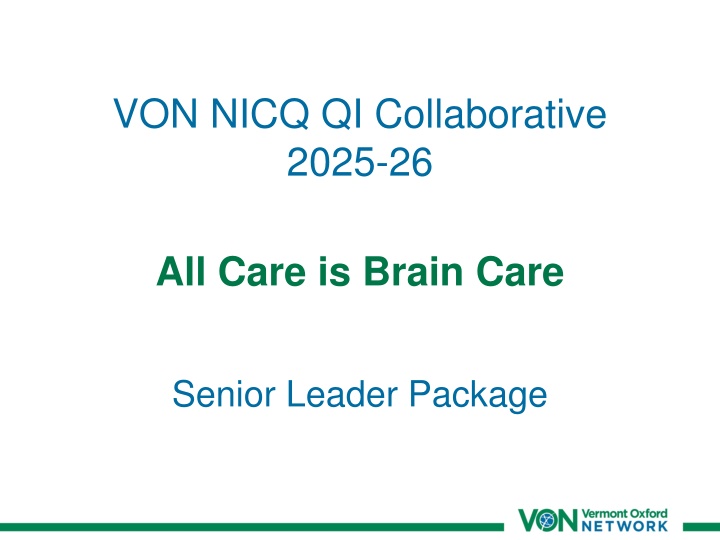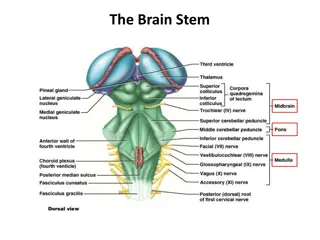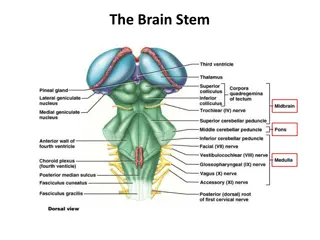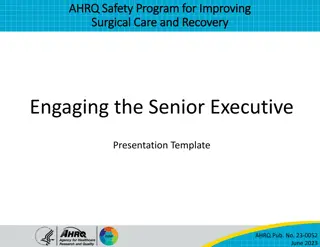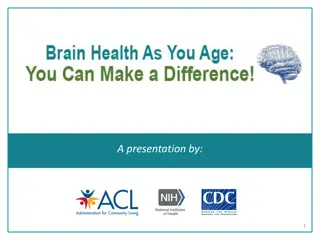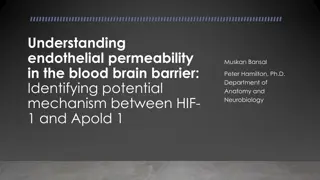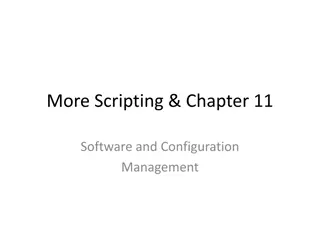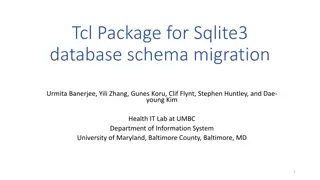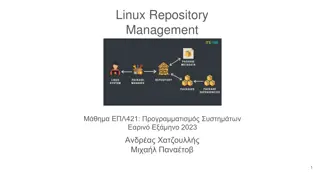VON.NICQ.QI Collaborative 2025-26: All Care is Brain Care Senior Leader Package
Vermont Oxford Network is a non-profit collaborative with over 30 years of neonatal quality improvement experience. Their project focuses on neuroprotective care for newborns to ensure optimal development. The initiative includes small group collaborations, customized benchmarked data reports, and faculty-led webinars, aiming to enhance care quality through education and research.
Download Presentation

Please find below an Image/Link to download the presentation.
The content on the website is provided AS IS for your information and personal use only. It may not be sold, licensed, or shared on other websites without obtaining consent from the author.If you encounter any issues during the download, it is possible that the publisher has removed the file from their server.
You are allowed to download the files provided on this website for personal or commercial use, subject to the condition that they are used lawfully. All files are the property of their respective owners.
The content on the website is provided AS IS for your information and personal use only. It may not be sold, licensed, or shared on other websites without obtaining consent from the author.
E N D
Presentation Transcript
VON NICQ QI Collaborative 2025-26 All Care is Brain Care Senior Leader Package
Table of Contents Topic Page What is Vermont Oxford Network 3 Project overview 4 Collaborative Improvement Topics 8 Identify Local Opportunities 11 Rationale for Participation 12 Results of VON QI 13 Next steps 15 2
What is Vermont Oxford Network Non-profit voluntary collaborative More than 30 years experience in multidisciplinary neonatal QI with participation of over 750 NICU teams Neutral, independent party in analyzing and providing benchmarking data Publication of over 300 research papers using VON data https://public.vtoxford.org/research/ World s largest voluntary database for very low birth weight infants and neonatal intensive care admissions. Mission: To improve the quality, safety, and value of care for newborn infants and their families through a coordinated program of data-driven quality improvement, education, and research. Vision: A worldwide community dedicated to giving infants the best possible start so that every newborn and family achieves their fullest potential. 3
Project overview While we continue to work to improve survival rates across the span of neonatal critical illnesses, we cannot do so at the expense of, or without clear focus on, our ability to safeguard the full potential of each infant. Much of what we do as healthcare providers is out of necessity, is not neuroprotective, and is potentially harmful over time. Our goal is that each care interaction with a newborn is approached with a neuroprotective lens, balancing benefit and harm, supporting normal maturation and preventing injury. PREVENT injury PROTECT normal maturation and development PROMOTE positive experiences and relationships 4
All Care is Brain Care 2025-26 NICQ 2 Year commitment - $25,000/yr Small group collaboration faculty led Custom benchmarked VON data reports & audits Faculty team coaching with continuous collaboration with colleagues Dedicated Homeroom meetings (5-6) VON hosted in person meetings Spring 2025 and 2 days in conjunction with 2026 Quality Congress ONSITE in person meeting at member site in spring 2026 with clinical immersion 5
All Care is Brain Care 2025-26 NICQ iNICQ 2 Year commitment Improvement Topic Content Webinars (6) led by Homeoom faculty Year to Year commitment Small group collaboration Custom benchmarked VON data reports & audits Virtual collaboration with topical community colleagues through the year CME/CNE for webinars and educational courses Faculty team coaching and leading and continuous collaboration with colleagues MOC Part 4 credits for physicians with QI poster 1 Day in person meeting in conjunction with 2026 Quality Congress Homeroom meetings (5-6) All online collaborative resources VON hosted in person meetings Spring 2025 and 2 days in conjunction with 2026 Quality Congress QI Foundations, Collaborative Spotlight, Responding to NAS courses for all center team members ONSITE immersive in person meeting at member site 6
All Care is Brain Care 2025-26 All Collaborative Members Improvement Topic Content Webinars (6) led by Homeroom faculty CME/CNE for webinars and educational courses MOC Part 4 credits for physicians with QI poster All online collaborative resources QI Foundations, Collaborative Spotlight, Responding to NAS courses for all center team members 7
2025-26 Collaborative Improvement Topics & Preliminary PBPs NOTE: minimum 8 NICQ teams required to confirm any topic Reduce Pain & Pokes Minimizing requirement for blood draws; optimize skin-to-skin including during care; non-pharmacologic pain management including containment, 4-handed care, and skin-to-skin; decrease opiate use; evidence- based pharmacologic pain management. Bundling Care to Reduce Severe IVH Use of antenatal steroids and magnesium sulphate; team pre-briefing of roles & responsibilities including birthing colleagues; maintain normothermia; delayed cord clamping; avoid hypocapnia; utilize gentle ventilation; slow blood draws and IV boluses; elevated head of bed; skin to skin within 72 hours; prophylactic indomethacin; minimal stimulation and handling by staff; timely transfer from referral hospital to receive neuro-intensive evaluation and care. 8
2025-26 Collaborative Improvement Topics & Preliminary PBPs - continued Neuroprotective Lung Strategies Non-invasive ventilation; non-invasive surfactant administration; establish effective ventilation; establish competencies with intubation; titrate oxygen; avoid hypocapnia. Promote Positive Sensory Experiences & Relationships Neuroprotective practices; minimize separation from family; promote skin to skin care; language stimulation; containment; promote positive auditory, tactile, vestibular, visual, kinesthetic, olfactory, and gustatory experiences. Health Equity & Follow Through Assessing practices and outcomes through the lens of race & ethnicity; screening for social determinants of health; establish equity-related never events; language & communication support; preparing families for life beyond the NICU. 9
2025-26 Collaborative Improvement Topics & Preliminary PBPs - continued Parental Wellbeing & Mental Health Parent screening for mental health; determining or developing access to mental health support; establish partnership with OB to assess and promote parental wellbeing during antenatal visits. Optimizing Care for Neonatal Encephalopathy Brain monitoring protocol to evaluate neonates at risk for seizure using amplitude integrated EEG or conventional video-EEG; Early identification of treatment candidates for therapeutic hypothermia; timely transfer and/or initiation of treatment; active therapeutic hypothermia on transport; communication with families; follow through. Optimizing Neurodevelopment for Infants with BPD Positive, age-appropriate social and developmental experiences; maintaining optimal respiratory support and oxygenation; minimize pain and stress; optimal timing for tracheostomy; promote sleep; minimize sedation; utilize optimal respiratory care strategies; optimize nutrition; promote neuro-recovery. 10
Identify Local Opportunities Complete center-level discernment Practice Gap Assessments provided for each topic. Review practices for any topic(s) of interests. Determine priority of improvement focus with team. Visit Nightingale report links, updated with 2022 benchmark data. Links will be updated with 2023 data when reporting completed by VON Stats team in summer 2024. https://public.vtoxford.org/quality-education/inicq/all-care-is-brain-care-nightingale-reports/ Prepare Rationale for participation Follow prompts on next slide to prepare a request for support Request a consultation with VON if you have questions to inform your center s request of support from your Leadership. Contact John Lester at jlester@vtoxford.org Review the Return on Investment package Share Return on Investment and Rationale with your Senior Leaders. 11
Rationale for Participation To be completed by Team respond to the prompts below and replace text in italics add slides as required Key items of interest to your team from your Practice Gap Assessment(s). VON benchmarking data supporting rationale for participation Nightingale data reports for your center where your 2022 data indicates you have the potential for improvement (i.e. not yet performing at the best rate compared to the network). Links to Nightingale data reports available on the VON website: https://public.vtoxford.org/quality-education/inicq/all-care- is-brain-care-nightingale-reports/ Alignment with organizational goals and priorities Describe how this project aligns with your organization s goals and priorities. Consider department level, program level, and organization level. Multidisciplinary and Family Engagement Report the anticipated level of interest and engagement from your team. How many disciplines will be impacted? How will this project advance engagement of families as partners in care and in quality improvement? 12
Results of VON QI More than 30 Years of Measurable Improvement VON teams have achieved measurable improvement through data-driven, disciplined QI to test and implement evidence-based practices. Economic Implications of Neonatal Intensive Care Unit Collaborative Quality Improvement. Pediatrics January 2001, 107 (1) 23-29; DOI: https://doi.org/10.1542/peds.107.1.23 In the mid-90s, VON QI collaborative teams reduced infection rate from 22% to 16.6% resulting in an average savings per center of $2.3 million. Collaborative Quality Improvement for Neonatal Intensive Care. Pediatrics January 2001, 107 (1) 14-22; DOI: https://doi.org/10.1542/peds.107.1.14 Teams participating in our Neonatal Abstinence Syndrome internet-based collaborative reduced length of stay on average from 21 days to 19 days. Some centers had even more substantial improvements, including reduction of LOS by 9.9 days per patient for a cost savings of nearly $430,000. Pediatrics May 2016 137 (5): e20153835. https://doi.org/10.1542/peds.2015-3835 Teams participating in iNICQ for antibiotic stewardship in newborn care reduced median Antibiotic Utilization Rate (AUR) in 2016-2017 from 16.7% to 12.1% for a 34% relative risk reduction. Pediatrics December 2019 144 (6): e20190589. https://doi.org/10.1542/peds.2019-0589 13
Results of VON QI Teams in NICQ Homerooms have focused on specific clinical issues or patient populations, including care of micro-premature infants, improving chronic lung disease, and optimizing nutrition. In 2017-18 teams in a Homeroom reduced rates of chronic lung disease for the smallest infants from 52% to 44%, and Periventricular-Intraventricular Hemorrhage (P-IVH) Grade 4 from 5.8% to 3.1%. 14
Next Steps Respond to NICQ Homeroom interest and preferences survey. Let us know your level of interest and any additional information we can provide to support your decision- making. Please provide one response for your team by July 1. https://www.surveymonkey.com/r/ACisBC_NICQ2025-26_NICQ We are here to support you. If you would like to schedule a zoom call to assist with your decision-making or to have questions addressed, please contact John Lester. John Lester - NICQ and iNICQ Coordinating Consultant jlester@vtoxford.org And for Health Systems (minimum 8 centers from one system minimum forming a Homeroom), please contact Denise Zayack. Denise Zayack - Senior Consultant for Quality Improvement & Education dzayack@vtoxford.org Thank you for your commitment to improvement and for your partnership with VON. 15
